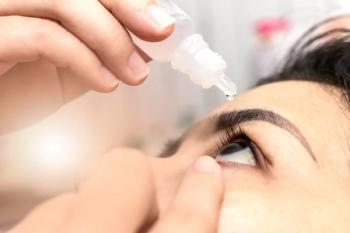
- November digital edition 2024
- Volume 16
- Issue 10
Is there a relationship between keratoconus and diabetes?
Studies point to an inverse association between diabetes and keratoconus risk.
Diabetes is known to induce multiple effects on the cornea, including keratopathy, neuropathy, inflammation, alterations in collagen fibrils, and endothelial cell loss.1 Most, but not all, studies have suggested that diabetes is inversely associated with the risk of keratoconus, suggesting a protective role against the development and/or severity of corneal ectasia.2-4 Some other studies contrast these findings, having reported either a positive association between prevalence and severity of keratoconus in patients with diabetes5 or no significant association between the 2 diseases.6 This discrepancy may be a consequence of varying sample sizes, differing inclusion and exclusion criteria, and specific populations being analyzed.
The cornea must be elastic enough to expand into an aspheric shape but stiff enough to maintain that shape and resist the force of intraocular pressure. There is a delicate balance between the multiple corneal layers and the composition of each layer that contributes to the overall corneal shape, its structural integrity, and its clarity. This involves the organization of collagen fibrils within each layer, the presence and attachment of proteoglycans and glycosaminoglycans to these collagen fibers, the corneal swelling pressure as a function of intraocular pressure pushing fluid into the cornea and the pumping effects of the corneal endothelium to limit that fluid uptake, and both the production and degradation of extracellular matrix components.7 Three major mechanisms of corneal collagen cross-linking have been identified, including an enzymatic reaction (lysyl oxidase–mediated cross-linking) and 2 nonenzymatic reactions (endogenous advanced glycation end product [AGE]–mediated cross-linking and the development of photooxidative cross-linking mediated by riboflavin, a now commonly deployed treatment option for keratoconus).8
The accelerated formation and deposition of AGEs resulting from chronic hyperglycemia in diabetes plausibly explain reduced risk of keratoconus in patients with diabetes, as AGEs are significantly higher in all tissues of patients with diabetes, including the cornea, and this process might strengthen corneal collagen in a way that inhibits both corneal thinning and ectasia. AGE levels increase with age (in patients without diabetes) and degree/duration of hyperglycemia, consistent with the clinical observation that keratoconus typically becomes manifest in younger patients and that higher glycated hemoglobin A1c levels are associated with reduced severity of keratoconus.3 In a retrospective, longitudinal population-based cohort study in the United States, investigators found that incidences of keratoconus in (predominantly type 2) diabetes without complications were 20% less likely to occur, with a 52% lower odds of keratoconus development in those with renal, retinal, neuropathic, or cardiovascular diabetes complications.9
As for some reports linking increased risk of keratoconus to diabetes, diabetes diagnosis came after the development of keratoconus in type 2 diabetes10 (there was no increased risk in type 1 diabetes), suggesting that hyperglycemia plays little or no role in the onset of the former and that other comingling environmental contributors independently linked to both keratoconus and obesity-related type 2 diabetes (eg, sleep apnea) might help explain any positive or neutral association between the 2 disorders.
At present, there appears to be more evidence supporting a protective role of coexisting diabetes in patients with keratoconus. This raises the potential of finding and developing therapeutic targets for keratoconus management that strengthen the cornea through similar mechanisms that affect the cornea in diabetes, provided these same molecular pathways do not result in other corneal pathological processes common in diabetes (eg, increased risk of infection and corneal hypoesthesia, decreased adherence of corneal epithelium, and loss of endothelial cells and/or function). One example would be upregulating lysyl oxidase (LOX) in keratoconic corneas similarly to that seen in diabetes, thereby enhancing LOX-mediated collagen cross-linking.11
References:
Ljubimov AV. Diabetic complications in the cornea. Vision Res. 2017;139:138-152. doi:10.1016/j.visres.2017.03.002
Seiler T, Huhle S, Spoerl E, Kunath H. Manifest diabetes and keratoconus: a retrospective case-control study. Graefes Arch Clin Exp Ophthalmol. 2000;238(10):822-825. doi:10.1007/s004179900111
Kuo IC, Broman A, Pirouzmanesh A, Melia M. Is there an association between diabetes and keratoconus? Ophthalmology. 2006;113(2):184-190. doi:10.1016/j.ophtha.2005.10.009
Naderan M, Naderan M, Rezagholizadeh F, Zolfaghari M, Pahlevani R, Rajabi MT. Association between diabetes and keratoconus: a case-control study. Cornea. 2014;33(12):1271-1273. doi:10.1097/ICO.0000000000000282
Bak-Nielsen S, Ramlau-Hansen CH, Ivarsen A, Plana-Ripoll O, Hjortdal J. A nationwide population-based study of social demographic factors, associated diseases and mortality of keratoconus patients in Denmark from 1977 to 2015. Acta Ophthalmol. 2019;97(5):497-504. doi:10.1111/aos.13961
Claessens JLJ, Godefrooij DA, Vink G, Frank LE, Wisse RPL. Nationwide epidemiological approach to identify associations between keratoconus and immune-mediated diseases. Br J Ophthalmol. 2022;106(10):1350-1354. doi:10.1136/bjophthalmol-2021-318804
Kling S, Hafezi F. Corneal biomechanics - a review. Ophthalmic Physiol Opt. 2017;37(3):240-252. doi:10.1111/opo.12345
McKay TB, Priyadarsini S, Karamichos D. Mechanisms of collagen crosslinking in diabetes and keratoconus. Cells. 2019;8(10):1239. doi:10.3390/cells8101239
Woodward MA, Blachley TS, Stein JD. The association between sociodemographic factors, common systemic diseases, and keratoconus: an analysis of a nationwide heath care claims database. Ophthalmology. 2016;123(3):457-465.e2. doi:10.1016/j.ophtha.2015.10.035
Kosker M, Suri K, Hammersmith KM, Nassef AH, Nagra K, Rapuano CJ. Another look at the association between diabetes and keratoconus. Cornea. 2014;33(8):774-779. doi:10.1097/ICO.0000000000000167
Ates KM, Estes AJ, Liu Y. Potential underlying genetic associations between keratoconus and diabetes mellitus. Adv Ophthalmol Pract Res. 2021;1(1):100005. doi:10.1016/j.aopr.2021.100005
Articles in this issue
about 1 year ago
EnVisioning the future of eye careabout 1 year ago
The white cane and beyond: Part 2about 1 year ago
Rate my management: Diving deep into a case of glaucomaabout 1 year ago
Understanding blue light: Making sense of the spectrumabout 1 year ago
The ABC's of cornea healthabout 1 year ago
Semifluorinated alkanes in dry eye diseaseNewsletter
Want more insights like this? Subscribe to Optometry Times and get clinical pearls and practice tips delivered straight to your inbox.
















































.png)


